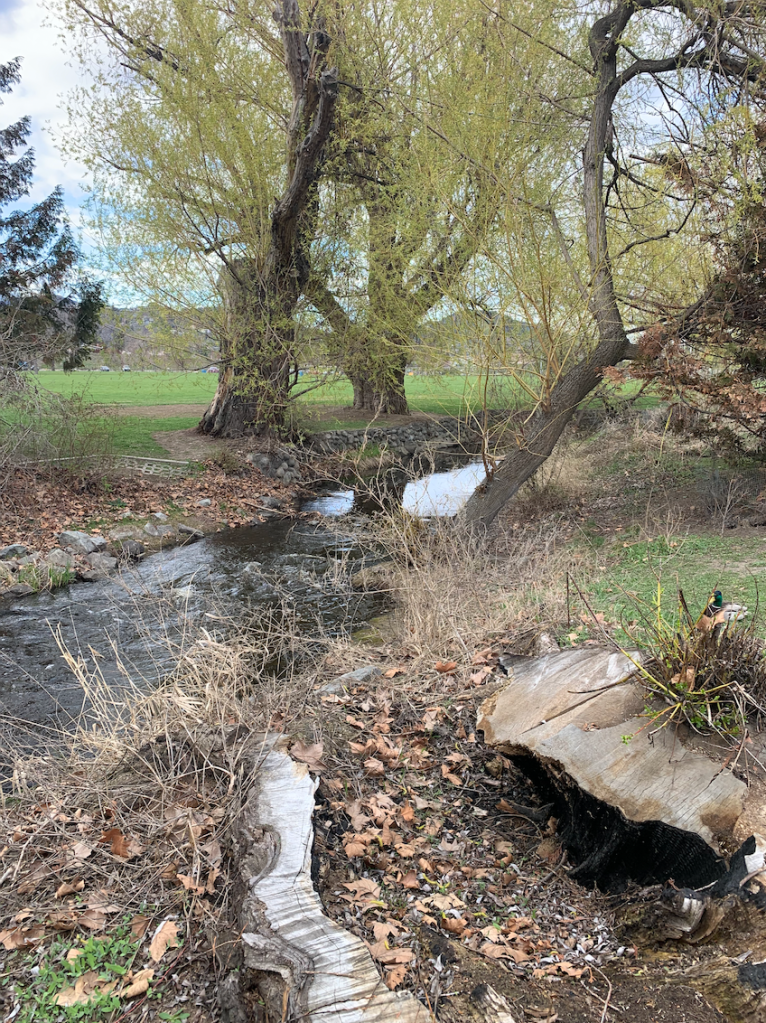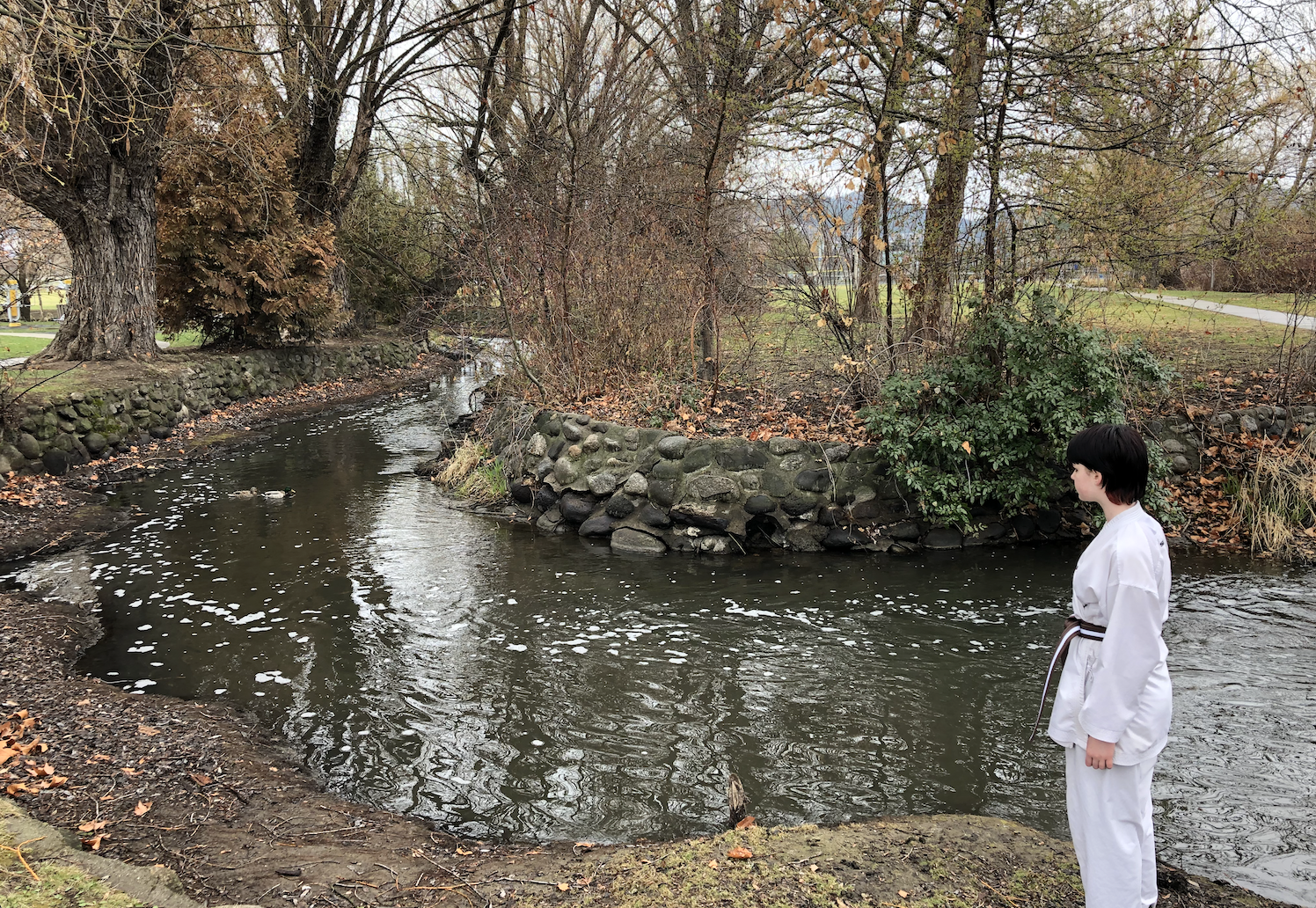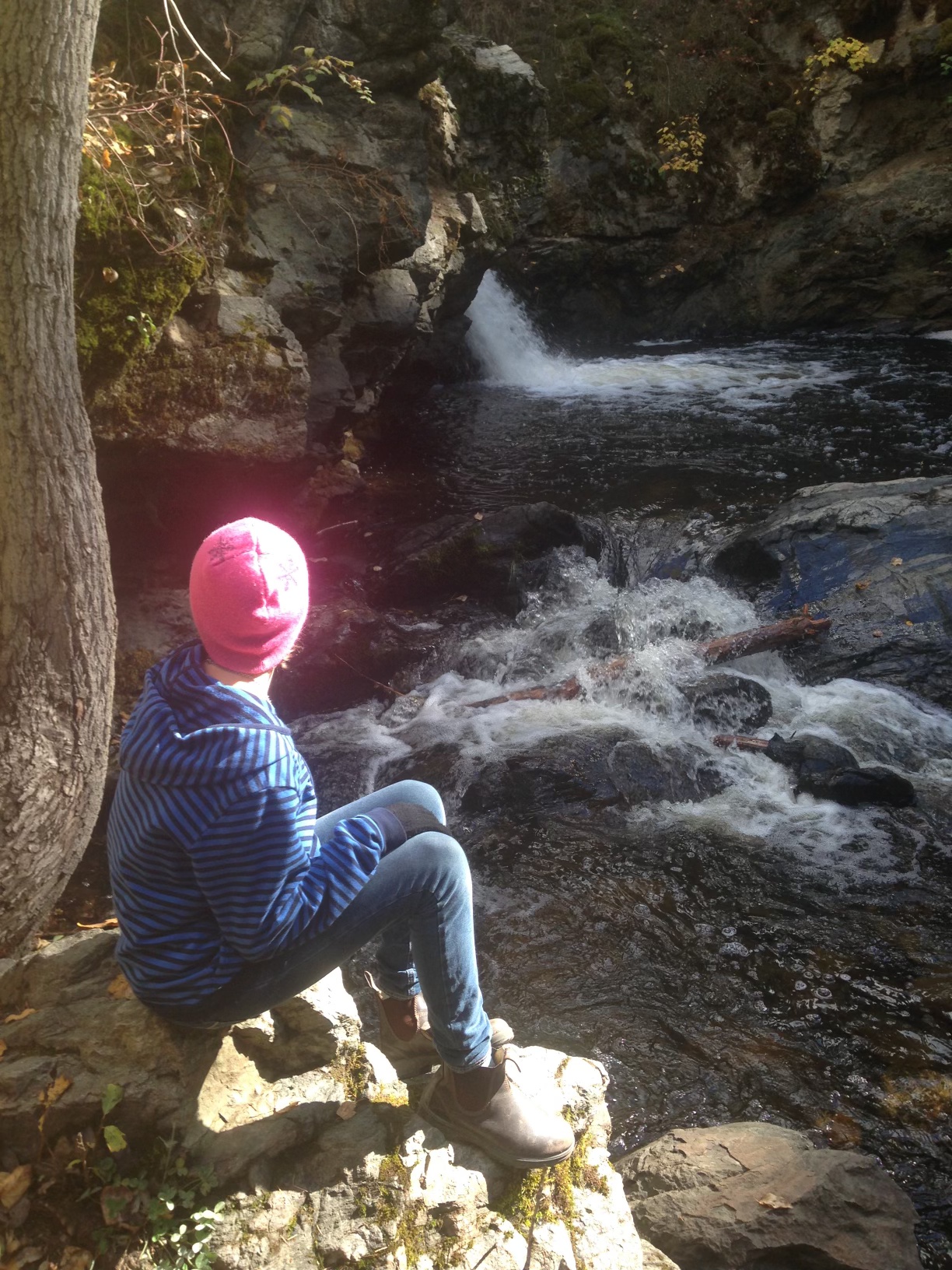Neela Rader (they/them) is a sibling, artist, and community organizer living in the traditional, unceded, and currently occupied territories of the syilx people. They love David Bowie, playing the fiddle, and spending time with their sibling.
This FEELed Note is part of our occasonal series featuring outstanding feelz from undergraduate students.
In the springtime of 2017, Mill Creek flooded. Mill Creek flows through traditional, unceded, and ancestral syilx territory, from “the east side of the Okanagan Basin into Okanagan Lake” (“Mill Creek”). My apartment building sits only a few metres away from the Creek, so when it rose, the spring weather was literally at my doorstep. According to Astrida Neimanis and Jennifer Mae Hamilton, the weather can be understood as both meteorological and more-than meteorological (81, 82). They write that weathering is “a particular way of understanding how bodies, places and the weather are all inter-implicated in our climate-changing world” (80). That spring, Earth’s tilt toward the sun caused more heat energy to reach syilx territory, turning the snow on the mountaintops into water, which moved with gravity into the Creek and made the levels higher. In part, the meteorological weather brought the Creek to my doorstep.
But the weather was also colonialism. The first dam was put near the headwaters of Mill Creek about 100 years ago (“Mill Creek”) so that early settlers could control the annual flooding and build on what was once marsh and floodplain. Other colonial technologies included water diversion and channelization (“Mill Creek”). The City of Kelowna ostensibly owns and manages the Creek and surrounding riparian ecosystem, making decisions about and changes to this place without any recognition of syilx sovereignty. In fact, the City of Kelowna actively undermines syilx lifeways (fishing, treaty-making, harvesting) in its harmful relations with the Creek. My apartment building is only able to exist because of the colonial technologies of damming, diversion, and channelization. Without them, the abundant spring floods would destroy the building’s foundation. When I helped my neighbours protect our underground parkade by putting sandbags around the perimeter of the building, I was deeply entangled with meteorological weather and more-than-meteorological weather.
But weathering is more than just understanding the ways meteorological and more-than-meteorological weathers meet; “weathering also names a practice or a tactic: to weather means to pay attention to how bodies and places respond to weather-worlds which they are also making” (Neimanis and Hamilton 81). Paying attention to how different bodies weather the weather differently is key to an ecofeminist understanding of solidarities, “difference and intersectionality” (Neimanis and Hamilton 81), not just between humans, but with other bodies of water too. How is the creek weathering the weather? According to Okanagan Basin Water Board, “reduced freshet peak flows from floodwater diversions to Mission Creek, as well as extensive water storage activities, have reduced the stream’s seasonal ability to blow out beaver dams” (“Mill Creek”). Urbanization and pollution have also decreased salmon spawning and other riparian species’ habitat (“Mill Creek”). Settler-colonial water control has made the Creek less and less able to give life. But I weather it differently.

For me, the dams, diversions, and channelization on Mill Creek function as shadow places. Val Plumwood defines shadow places as “places that provide our material and ecological support, most of which, in a global market, are likely to elude our knowledge and responsibility.” As I write this from my apartment building, I can see the Creek and its low water levels, but the places upstream that keep the levels low and my building untouched are invisible to me. Without those places, I would not live in this place, at least not in the ways I do now. The shadow places are also my places. While the Creek is harmed, I weather the dams and diversions with ease.
Mill Creek is my more-than-human kin. Anthropologist Marshall Sahlins defines kin as “a mutuality of being”– certainly, my being and the Creek’s being are entangled. Part of my being, the place where I live, is dependent on ongoing colonialism in syilx territory. But simply recognizing how I benefit from colonial harms to Mill Creek is not enough. Neimanis and Hamilton write, “to weather responsively means to consider how we might weather differently–better–and act in ways that move towards such change” (81). What change would be required to mend these harms of colonial water control? The Syilx Nation Siwɬkʷ Declaration offers this: “Syilx peoples assert that siwɬkʷ [water] has the right to be recognized as a familial entity, a relation, and a being with a spirit who provides life for all living things.” Perhaps understanding the flood as a gift of life is a step towards weathering better.
There are important feminist lessons to be learned from Mill Creek’s 2017 flood. As Val Plumwood articulates with her concept of the “master model,” the human/nature hierarchy is always connected with man/woman (and other oppressive binaries), and therefore must be dismantled. The flood is a direct challenge to the master model, forcing humans to contend with the failure of their attempts at domination. That spring, I remember sitting on the stone wall that holds the Creek in place and seeing two sets of beady eyes and slick bodies coming towards me–river otters. They were swimming upstream, greeting me with their bobbing heads. This rare experience was made possible by the Creek’s gentle and generous flood, by its resistance to colonialism. It challenged settler domination over land, premised on anthropocentrism, and gave life to the tmxwulaxw and timixw (Syilx Nation Siwɬkʷ Declaration).

Around the time of the 2017 flood, I often made a game of cleaning up garbage at the Creek with my friends. One of us would dislodge garbage in the water and the rest would try to use sticks to remove it as it flowed past. I was eleven years old and trying to do right by the Creek by cleaning it up, instilling in me some small sense of responsibility for the creek. Still, I could not see the root injustices of displacement and colonization, so my efforts at restoration were insufficient. In Pleasure Activism, adrienne maree brown offers transformative justice as a tool to move beyond shallow responses to harm. She writes, “I believe in transformative justice–that rather than punishing people for surface-level behavior, or restoring conditions to where they were before the harm happened, we need to find the roots of the harm, together, and make the harm impossible in the future” (Pleasure Activism). So how can I practice transformative justice with the Creek, my more-than-human kin, and make a relationship of control and domination impossible in the future?
I do not have all the answers. So, to move towards transformation, I want to call on two key ecofeminist tools: reciprocity and humility. I learned about reciprocity with more-than-human kin from The Syilx Nation Siwɬkʷ Declaration, which asserts that “[s]iwɬkʷ must be treated with honour, respect, and reciprocity.” This means not simply being thankful for when the water gifts us life but giving it life back. This means affirming syilx sovereignty by not making decisions about siwɬkʷ without syilx, interrupting the settler-colonial sense of entitlement to Land (Liboiron 67-69). Alexis Pauline Gumbs teaches me about humility; “MUCH RESPECT!” she tells her more-than-human kin, “I am at your service. I am in your debt. What can I offer?” (Gumbs 26). When the Creek responds, Gumbs reminds me, listen–this is the first step of many. These feminist principles of reciprocity and humility remind me that knowledge is always situated, and that care is powerful.
Thank you to those who have guided me in my learning about this place and its connection to broader ecofeminist thinking, brown, Haraway, Neimanis, Hamilton, Plumwood, and beyond. Thank you to the Creek, the river otters, the salmon, the beavers, and the many other more-than-human kin with whom I am entangled. Let this be a beginning. May my learning evolve and grow. May my love for the Creek expand, until it is big enough to hold the change that needs to come.

Works Cited
brown, adrienne maree. “Introduction.” Pleasure Activism: The Politics of Feeling Good, AK Press, 2019.
Haraway, Donna. When Species Meet. University of Michigan Press, 2008.
Liboiron, Max. “Introduction.” Pollution is Colonialism, Duke University Press, 2021.
Sahlins, Marshal. What Kinship Is– And Is Not. University of Chicago Press, 2013.
Neimanis, Astrida and Hamilton, Jennifer Mae. “open space weathering.” feminist review, vol. 1, 2018, pp. 80-84.
Plumwood, Val. “Shadow Places and the Politics of Dwelling.” Australian Humanities Review, https://australianhumanitiesreview.org/2008/03/01/shadow-places-and-the-politics-of-dwelling/. Accessed 16 March 2024.
“Mill Creek.” Okanagan Basin Water Board. https://obwb.ca/efndocs/EFN_report_ 2020_3_12.pdf. Accessed 16 March 2024.
“Syilx Nation Siwɬkʷ Declaration.” Okanagan Nation Alliance, https://www.syilx.org/wp/wp-content/uploads/2016/11/Okanagan-Nation-Water-Declaration_Final_CEC_Adopte d_July_31_2014.pdf. Accessed 16 March 2024.
